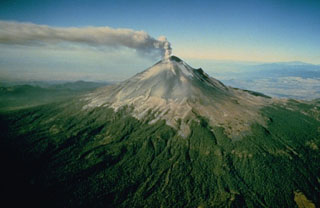Report on Popocatepetl (Mexico) — November 1993
Bulletin of the Global Volcanism Network, vol. 18, no. 11 (November 1993)
Managing Editor: Richard Wunderman.
Popocatepetl (Mexico) Steam cloud extends to 50 km; no seismicity
Please cite this report as:
Global Volcanism Program, 1993. Report on Popocatepetl (Mexico) (Wunderman, R., ed.). Bulletin of the Global Volcanism Network, 18:11. Smithsonian Institution. https://doi.org/10.5479/si.GVP.BGVN199311-341090
Popocatepetl
Mexico
19.023°N, 98.622°W; summit elev. 5393 m
All times are local (unless otherwise noted)
During October-November a cluster of steam vents in Popocatépetl's 850 x 650-m summit crater produced substantial output. The resulting clouds reached 6,000 m elevation and were visible from 50 km E (Puebla City). On 13, 14, and 21 November, fumarolic activity led to 50-km-long, off-white plumes. The increased steam output has not been correlated to changes in visible structure, to seasonal conditions, or to seismic activity monitored on a portable seismometer. An unconfirmed account by one climber returning from the summit crater in mid-November told of strong sulfur smells, a small green lake, and occasional phreatic eruptions reaching over 200-m height.
Geological Summary. Volcán Popocatépetl, whose name is the Aztec word for smoking mountain, rises 70 km SE of Mexico City to form North America's 2nd-highest volcano. The glacier-clad stratovolcano contains a steep-walled, 400 x 600 m wide crater. The generally symmetrical volcano is modified by the sharp-peaked Ventorrillo on the NW, a remnant of an earlier volcano. At least three previous major cones were destroyed by gravitational failure during the Pleistocene, producing massive debris-avalanche deposits covering broad areas to the south. The modern volcano was constructed south of the late-Pleistocene to Holocene El Fraile cone. Three major Plinian eruptions, the most recent of which took place about 800 CE, have occurred since the mid-Holocene, accompanied by pyroclastic flows and voluminous lahars that swept basins below the volcano. Frequent historical eruptions, first recorded in Aztec codices, have occurred since Pre-Columbian time.
Information Contacts: Alejandro Rivera Dominguez, Univ Autónoma de Puebla; S. O'Meara, Sky & Telescope.

